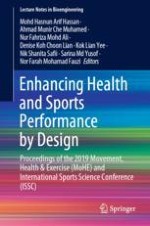2020 | Book
Enhancing Health and Sports Performance by Design
Proceedings of the 2019 Movement, Health & Exercise (MoHE) and International Sports Science Conference (ISSC)
Editors: Dr. Mohd Hasnun Arif Hassan, Dr. Ahmad Munir Che Muhamed, Nur Fahriza Mohd Ali, Dr. Denise Koh Choon Lian, Dr. Kok Lian Yee, Dr. Nik Shanita Safii, Dr. Sarina Md Yusof, Dr. Nor Farah Mohamad Fauzi
Publisher: Springer Singapore
Book Series : Lecture Notes in Bioengineering
